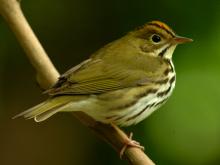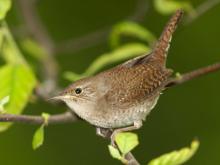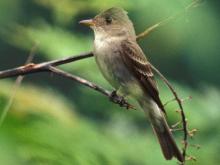Birds
Media

Species Types
Scientific Name
Seiurus aurocapilla
Description
Ovenbirds sing a clear, ringing "TEACHer-TEACHer-TEACHer-TEACHer" that gets progressively louder. A common migrant, it forages among leaves on the forest floor.
Media

Species Types
Scientific Name
Cardinalis cardinalis
Description
The male northern cardinal is a bright red bird with a head crest and black mask. An excellent singer, this familiar backyard bird is beloved by many.
Media

Species Types
Scientific Name
Pheucticus ludovicianus
Description
The rose-breasted grosbeak's song is a beautiful, robin-like carol. Grosbeaks are chubby birds with heavy bills used for gathering and eating beetles, seeds, and fruits.
Media

Species Types
Scientific Name
Troglodytes aedon
Description
These audacious little birds are favorite spring arrivals, partly because of their bold bursts of song, but also because of their bold habits around people.
Media

Species Types
Scientific Name
Contopus virens
Description
Its distinctive, slurred “pee-a-wee” song helps differentiate the eastern wood-pewee from our other flycatchers, and from most other small, olive-brown birds.
Media

Species Types
Scientific Name
Sayornis phoebe
Description
Eastern phoebes often build their mud-and-plant nests on the side of a house, just under a roof or other overhang. These small flycatchers repeatedly cry out their own name: “FEE-bee! FEE-bee!”
Media

Species Types
Scientific Name
Empidonax virescens
Description
The Acadian flycatcher is one of several flycatchers found in Missouri. It is a summer resident here, and like its relatives, it is much appreciated for its appetite for flying insects.
Media

Species Types
Scientific Name
Setophaga coronata (formerly Dendroica coronata)
Description
The yellow-rumped warbler is Missouri’s most abundant migrant warbler. It is also seen in winter. Adults have a yellow patch on the rump, the crown, and the sides near the bend of the wing.
See Also







Media

Species Types
Scientific Name
Hemaris diffinis
Description
The snowberry clearwing is a moth that confuses people because it looks like a bumblebee and flies like a hummingbird!
Media

Species Types
Scientific Name
Hyles lineata
Description
The white-lined sphinx moth sometimes confuses people because it flies, hovers, and eats from flowers like a hummingbird. The adults often fly during daylight hours as well as in the night and are often found at lights.
Media

Species Types
Scientific Name
Darapsa myron
Description
The Virginia creeper sphinx moth is common in woods and brushy areas and comes to lights at night. The larvae eat Virginia creeper and grape leaves.
Media

Species Types
Scientific Name
Perimyotis subflavus (formerly Pipistrellus subflavus)
Description
Tri-colored bats, formerly called eastern pipistrelles, are relatively small and look pale yellowish or pale reddish brown. The main hairs are dark gray at the base, broadly banded with yellowish brown, and tipped with dark brown.
Media

Species Types
Scientific Name
Myotis grisescens
Description
Gray myotises are difficult to distinguish from other mouse-eared bats. A key identifying feature of the gray myotis is that its wing is attached to the ankle and not at the base of the toes. It’s an endangered species.
Media

Species Types
Scientific Name
Myotis lucifugus
Description
The little brown myotis (little brown bat) is one of our most common bats, but populations are declining. White-nose syndrome has taken a heavy toll in northeastern states. This species is now listed as vulnerable across its range.
Media

Species Types
Scientific Name
Myotis sodalis
Description
The Indiana myotis, or Indiana bat, summers along streams and rivers in north Missouri, raising its young under the bark of certain trees. It is an endangered species.
About Birds in Missouri
About 350 species of birds are likely to be seen in Missouri, though nearly 400 have been recorded within our borders. Most people know a bird when they see one — it has feathers, wings, and a bill. Birds are warm-blooded, and most species can fly. Many migrate hundreds or thousands of miles. Birds lay hard-shelled eggs (often in a nest), and the parents care for the young. Many communicate with songs and calls.





















